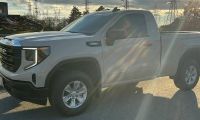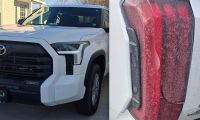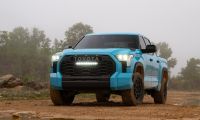General Motors has bitten the bullet in the last couple of years and recalled its hot-selling Chevy Bolt EV for fire risks. Now Ford has done something similar by halting production of its mega-popular and sought-after F-150 Lightning pickup because of a fire potential in its large battery version of the popular pickup.
Torque News Reporter Confirms News
In an announcement today, Ford confirmed the hold on its mega-popular pickup due to QC issues, according to John Goreham, Senior Reporter for Torque News. So far, there has been no further clarification from the automaker.
You may wonder why a popular vehicle like the Lightning, with thousands of copies, either sold, rolling off the assembly line, or waiting on dealer lots, would have a problem with potential battery fires. While we don’t know the official version of the problem, we can hazard a couple of rather informed guesses. It also covers Chevy’s Bolt EV.
First, an anecdote that illustrates the potential burning power of a storage battery unit. Some years ago, I was charging a battery-powered VHF walkie-talkie licensed in one of the FCC’s services. I didn’t realize there was a finite limit to the number of charges you could push through a high-powered wall unit before it gave up the ghost. Not thinking about this potential failure point, I just left the walkie-talkie – a sealed unit with rechargeable batteries inside that had to be replaced one at a time and soldered in place – on the charger and walked into our kitchen for dinner. After our dinner, helping with the chores, and reading emails, I went back into my office only to find the plastic case of the walkie-talkie about five times its size and growing by the minute (it kept getting fatter and noticeably hotter). It also had begun to smoke.
I quickly unplugged the walkie-talkie, poured water into a bucket, and, holding it by its antenna – not a great move, but it was the only one I could think of at the time – I gingerly let the sizzling unit sink to the bottom of the pail with the steam coming off it. And that was that, or so I thought. But, when I went to pull it out of the bucket and get rid of it, the chemical reaction that was sparked in the handheld unit started up again, and I literally ran down three flights with a small bucket full of cat sand and a shovel. I buried the bucket with the handheld inside, covering it with sand, not dirt. I then walked away for a couple of days, and when I returned, the reaction had completed. The once-slim handheld radio looked like a blimp, but it was cool to the touch and safe to dispose of properly (safety is one of the things you learn when you deal with radios and such).
Careful Disposal Needed
Before I disposed of the unit, I opened it up to look inside and found that there was a rather large pad of solder left when the soldering iron had yet to come away cleanly. It left a small potential bridge to a second cell in the unit. Unfortunately, for the unit, I had only completed the battery pack rebuild a couple of nights before, and it was the first charge of the unit with the rebuilt pack. I also opened the wall charging unit and found that the bridged cells had pulled current through so quickly that a regulator inside burned up, allowing a larger-than-normal charge rate to pass to the handheld. It was the perfect storm of possibilities, and the result was that an expensive unit was gone.
So, what does this rather long – true – anecdote show? It shows that unless batteries are handled correctly, they have the potential for smoldering and catching fire. The anecdote goes back to the early years of rechargeable technology using Nicads. It also shows that even a tiny battery supply that gave the handheld only 14.6 volts (direct current or DC) could get really hot and catch fire if there was a problem with the battery pack.
Now, let’s crank this up to Ford’s 131 kWh battery pack, the one that gives the F-150 Lightning its 320-mile range, and see what the problem might be. With a load of interconnected batteries that have to be charged by either slow charging or fast, high-speed charging, the potential for problems is all over the place.
Let’s assume you have a home wired for a slow – eight-hour – DC charger. Suppose one or two of the wires in the charging circuit are loose and touch. Then and there, you have a true short-circuit that you might not notice the problem for several charge cycles, as the wires are large enough to handle the added current from any short-circuiting for a while. Ultimately, the batteries will start to “boil off” as they heat even more due to the added current. (Batteries generate heat as they charge, as the original anecdote shows.) The problem might be external to the battery pack at a public charging point, for example, where bad handling of the charging head could lead to potential short circuits (crossed wires).
Potential Vehicle Problems Caused By Charging
Now, if your vehicle has access to a high-speed or high-capacity charging unit, it is possible that the frayed or touching internal wires might wear even more quickly, and since it is a high-capacity unit, it might result in a flash fire.
Why would batteries burn? The answer comes from the batteries themselves. With the advanced chemistry used in today’s batteries, the potential for fire is still there, while it isn’t great if things are done right. The battery packs, under the stress of high-capacity charging, can quickly overheat, causing the battery chemicals and the casing to combust. Very quickly, the vehicle will begin to smolder and ultimately burn.
That is what happened to Chevy’s Bolts that were recalled. And, while they aren’t talking about it, Ford seems to be leaning that way with its announcement that it is a QC (quality control) issue; Ford seems to be indicating that it is a problem with how things are being constructed. Ford has halted all production of the Lightning for the moment. Interestingly, according to Torque News reporting, pickups that are on dealer lots are still eligible for sale, which seems to indicate that it is a very recent problem as the problem only impacts those vehicles that are on the assembly lines or have just rolled off the Rouge EV Center assembly site.
Here you must remember the admission of Jim Farley, Ford CEO, who said last week that the wire looms of the F-150 Lighting contain way too much wire and that the automaker left at least $2.1 billion on the table because of it. With that much extra wiring in various looms doing nothing, the issue lies in an out-of-the-way spot that was overlooked.
Batteries Prove A Blessing And Problem
So, there you have it. Batteries are combustible. They have the potential to cause issues that right now are being overlooked in the mad rush to join Tesla and the other market leaders. When things completely washout in several years, today’s battery tech will likely be replaced by solid-state batteries and, perhaps, over-the-air charging, which inventor Nicola Tesla showed was possible 136 years ago (interestingly, he sat in the middle of the transmission cage while the charge was sent over the air for about 20 miles. He did this to prove to send AC -- alternating current -- could be done and that it was safe.) Tesla’s work was the basis for much of the data transmission, radio, and television we have today. It will likely be the basis for over-the-air charging soon.
Marc Stern has been an automotive writer since 1971 when an otherwise normal news editor said, "You're our new car editor," and dumped about 27 pounds of auto stuff on my desk. I was in heaven as I have been a gearhead from my early days. As a teen, I spent many misspent hours hanging out at gas stations (a big thing in my youth) and working on cars. From there on, it was a straight line to my first column for the paper "You Auto Know," an enterprise I handled faithfully for 32 years. Not many people know that I also handled computer documentation for a good part of my earnings while writing YAN. My best writing, though, was always in cars. My work has appeared in Popular Mechanics, Mechanix Illustrated, AutoWeek, SuperStock, Trailer Life, Old Cars Weekly, Special Interest Autos, etc. You can follow me on: Twitter or Facebook.











